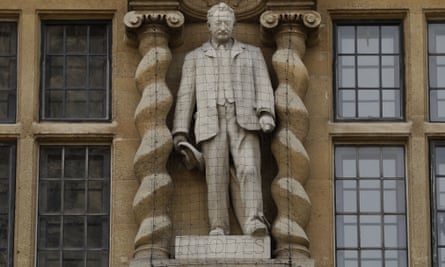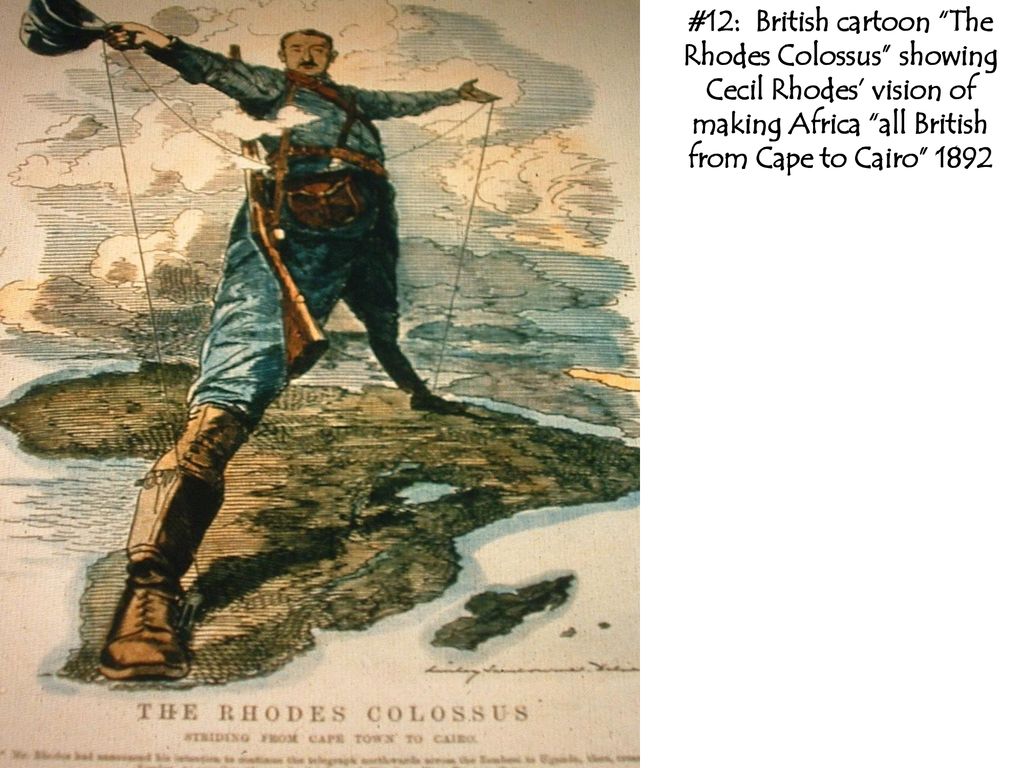Perspective
The history of racist colonial violence can help us understand police violence
Colonialism defined Blackness as inferiority

A likeness of Cecil Rhodes, the Victorian imperialist who supported apartheid-style measures in southern Africa, is seen mounted on the facade of Oriel College in Oxford, England, on June 9. (Matt Dunham/AP)

The recent police killings of George Floyd, Breonna Taylor and others have reignited a global movement against police violence and brutality. Black Lives Matter activists of various racial backgrounds have united to call attention to the devaluation of Black life in the United States and across the globe. As these activists have made clear, the problem of police violence is rooted in anti-Black racism
Even more, police violence in Black communities is rooted in the history of colonialism. This history, which dates to the 15th century, set in place a system of subjugation and control through conquest of the Americas and the enslavement of Africans. By remapping the world through colonial violence, European powers did more than brutalize non-White races — they carved out the very framework of racial categories as a way to justify their domination.
These racial categories remain firmly intact, shaping interactions between Black people and police forces. Present-day policing practices continue to mirror the colonialism that shaped the history of Africa since the 19th century.
AD
The German annihilation of the Herero people in South West Africa — what is now Namibia — stands out as a tragic example of how racism fueled violence. It is considered the first genocide of the 20th century. In the late 19th century, Germans had established several colonies in Africa, including South West Africa, which they saw as suitable for German settlement. The peoples living in the region — including the Herero, Nama and Khoikhoi — attempted to accommodate and resist German power. As German settlers came in greater numbers, they appropriated the land and cattle of the native Herero population and relied on their coerced and enslaved labor.
Although the Herero resisted, the Germans fought them. Gen. Lothar von Trotha and members of his military decided not merely to triumph over the local population but to annihilate them. Those who survived were separated from their cattle, denied access to water and forced to cross the desert near Botswana — a death march where many met their end. In 1904 alone, over 80 percent of the Herero population was wiped out. By then, Von Trotha had already honed his methods of colonial violence and even took pride in his tactics: “I destroy the African tribes with streams of blood and streams of money. Only following this cleansing can something new emerge, which will remain.”
Survivors were sent to Shark Island, a narrow peninsula jutting out into the Atlantic Ocean where Germany built one of its first concentration camps. Concentration camps were a technology created and refined in colonial settings, and many were produced during the same time period: by Germany in South West Africa, by Spain in Cuba, by Britain in South Africa, by the United States in the Philippines and so on.
AD
On Shark Island, the Herero and Nama peoples were beaten and starved, forced into physical and sexual slavery. Furthermore, as theorist Mahmood Mamdani points out, German geneticist Eugen Fischer ran medical breeding experiments on the Herero in concentration camps to study their physical and mental attributes. The scientific ideas developed in the colony were brought back to German institutions, where Fischer’s studies were later read by Adolf Hitler. One of Fischer’s students, Josef Mengele, later conducted human experimentation and sent people to their death in the Auschwitz gas chambers.
Before informing Nazi Nuremberg laws, Fischer’s experiments had an immediate effect on German colonies. After forcibly “breeding” Indigenous women with White Germans to study their offspring, he argued that people of different races should not be permitted to reproduce. His studies were used to validate racist conceptions of Black inferiority. The interplay of legal, scientific and cultural discourse within the colonies worked together to produce and maintain racial hierarchies.
Between 1904 and 1914, German officials debated and produced legislation based upon assumptions of race prohibiting interracial marriages in many territories. The May 1912 Reichstag debate on interracial marriages in the colonies brought racialized sexual politics to a national stage. Deputy Gov. Hans Tecklenburg considered mixed children “a cause of great concern and … highly dangerous in view of the situation in German South-West Africa.” He argued that “they not only have a negative effect on the purity of the German race and German civilization but also endanger the position of power of the white man in general.”
Although the Herero resisted, the Germans fought them. Gen. Lothar von Trotha and members of his military decided not merely to triumph over the local population but to annihilate them. Those who survived were separated from their cattle, denied access to water and forced to cross the desert near Botswana — a death march where many met their end. In 1904 alone, over 80 percent of the Herero population was wiped out. By then, Von Trotha had already honed his methods of colonial violence and even took pride in his tactics: “I destroy the African tribes with streams of blood and streams of money. Only following this cleansing can something new emerge, which will remain.”
Survivors were sent to Shark Island, a narrow peninsula jutting out into the Atlantic Ocean where Germany built one of its first concentration camps. Concentration camps were a technology created and refined in colonial settings, and many were produced during the same time period: by Germany in South West Africa, by Spain in Cuba, by Britain in South Africa, by the United States in the Philippines and so on.
AD
On Shark Island, the Herero and Nama peoples were beaten and starved, forced into physical and sexual slavery. Furthermore, as theorist Mahmood Mamdani points out, German geneticist Eugen Fischer ran medical breeding experiments on the Herero in concentration camps to study their physical and mental attributes. The scientific ideas developed in the colony were brought back to German institutions, where Fischer’s studies were later read by Adolf Hitler. One of Fischer’s students, Josef Mengele, later conducted human experimentation and sent people to their death in the Auschwitz gas chambers.
Before informing Nazi Nuremberg laws, Fischer’s experiments had an immediate effect on German colonies. After forcibly “breeding” Indigenous women with White Germans to study their offspring, he argued that people of different races should not be permitted to reproduce. His studies were used to validate racist conceptions of Black inferiority. The interplay of legal, scientific and cultural discourse within the colonies worked together to produce and maintain racial hierarchies.
Between 1904 and 1914, German officials debated and produced legislation based upon assumptions of race prohibiting interracial marriages in many territories. The May 1912 Reichstag debate on interracial marriages in the colonies brought racialized sexual politics to a national stage. Deputy Gov. Hans Tecklenburg considered mixed children “a cause of great concern and … highly dangerous in view of the situation in German South-West Africa.” He argued that “they not only have a negative effect on the purity of the German race and German civilization but also endanger the position of power of the white man in general.”
The United States legally banned interracial marriage for similar reasons. American laws devised from the 1600s, for example, defined the status of the children between Black enslaved people and White enslavers according to the “condition of the mother.” If the mother was Black, her children were legally designated as Black and thus considered enslaved people and property — or inheritable real estate of the enslaver, according to a 1705 Virginia legislative act. Categorizing the children of White fathers and Black mothers as Black largely kept those children from inheriting the land of the White enslaver as they were inheritable pieces of property. These German and U.S. legislative examples show that legal and state structures arbitrarily produced racial groups in a way that benefited Whiteness — and those considered Black were left with the ideological baggage that came with it.

Europeans justified the colonial project by framing it as a civilizing mission, a sentiment symbolically encapsulated in Rudyard Kipling’s phrase “white man’s burden.” The phrase conveyed an effort to civilize through the introduction of Western norms and to do so through the imposition of Western law. The colonial state set the colonizer apart from the colonized. It legally distinguished between a “civilized” political minority and a “not-yet-civilized” majority. It also helped make discrimination against the majority who were shut out of the state’s system of rights seem like the natural state of things. Race became the defining concept that marked the difference between these groups.
The production of Blackness as a racial and ideological category was evident in other ways. During the 19th and 20th centuries, the public display of Black people in Europe reinforced the idea of Blackness as inferior. This was made clear in the example of Saartjie Baartman, the South African woman taken to Europe and placed on display in a human zoo. When Baartman died, she was dissected and studied by French scientist Georges Cuvier. Her body parts were then put on display in a Paris museum.
Human zoos flourished between the 1870s and World War I, though many continued up until the 1940s. In the United States, many flocked to see Africans and other people of color on display in exhibitions, for example, in St. Louis in 1904 and Chicago in 1933. In 1906, owners of the Bronx Zoo encaged Ota Benga, a young Congolese man, comparing him to apes. These exhibitions thrived — along with the ideas about race produced within them.
Oppressive ideas about Blackness forged through European colonial violence and spread through science and culture help to contextualize the current public conversation surrounding violent policing in Black communities. They also explain why the uprisings sparked by George Floyd’s killing resulted in the toppling of colonial statues abroad. These recent events follow many years of protests and statue removals abroad.
In Africa, anti-colonial activists have been taking down statues celebrating colonial European figures for decades. In 1964, Kenyans took down a monument to King George VI and, in 2015, tore down a statue of Queen Victoria. That same year, a South African student threw excrement at a statue of British mining magnate Cecil Rhodes. A month later, his statue was removed with a crane, though in Zimbabwe, a monument of Rhodes was toppled back in 1980. There have been similar anti-colonial statue removals in other parts of the world, for example in Chile, where activists decapitated monuments to their Spanish conquerors late last year.
A
Floyd’s death at the hands of anti-Black police brutality reignited the spirit of anti-colonial activism and dissent. This year, in Bristol, a statue of slave trader Edward Colston was dumped into the harbor that once trafficked Africans. Meanwhile in the Africa Museum in Brussels, a statue of Belgium’s colonial king, Leopold II, responsible for the genocide of Congolese, has been defaced. These incidents capture the unmistakable connections between the problem of police violence and the history of colonial violence. Understanding these connections is a vital step toward seeking justice and redress in the United States and abroad.

Sarah OlutolaSarah Olutola is a graduate of McMaster University and she was the 2018-2019 Gordon F. Henderson postdoctoral fellow at The University of Ottawa's Human Rights Research and Education Centre. Her current academic research concerns postcolonialism, youth culture and representations of race in popular media culture.
No comments:
Post a Comment